Do you have a question about the Vertex Standard VXA-300 and is the answer not in the manual?
Overview of the Vertex Standard VXA-300 transceiver's capabilities and features.
Highlights include Omni-Glow display, NOAA weather monitoring, and memory channels.
Congratulates the user and encourages reading the manual for optimal performance.
Details compliance requirements for occupational use and safe operating practices.
Specifies SMA antenna jack and MIC/EAR jack usage.
Explains POWER/VOLUME and DIAL Selector knobs for operation.
BUSY/TX lamp, Loudspeaker, Microphone, and LCD display functions.
Describes primary, secondary, and third functions of keys.
Mechanism for battery removal.
PTT and MONITOR switches for transmission and squelch.
EXT DC Jack for external power connection.
Warnings regarding children, voltage, battery disposal, and water resistance.
Installation, removal, and charging procedures for the battery pack.
Details on using the charger and important notes on battery care.
How the display indicates low battery and advice on recharging.
Instructions for using the optional FBA-25 case with AA batteries.
Preliminary steps and turning the radio on for immediate use.
Tuning via keypad, DIAL selector, and volume adjustment.
Using Menu Item 01 "SQL" to set the squelch threshold.
Quick access to the 121.5 MHz emergency channel.
How to transmit using the PTT switch and return to receive mode.
Describes VFO, MR, BOOK, and WX tuning methods for frequency selection.
Covers weather channel scanning, alerts, monitor key, ANL, and temp/battery display.
Switching temperature units and recalibrating the thermometer.
Locking/unlocking keypad and controls to prevent accidental changes.
Setting battery saver ratio and enabling/disabling keypad beeper.
Adjusting channel step increments for air bands.
Notes on display, receive-only, and selectivity for 8.33 kHz step.
Selecting receiver audio responses for comfortable listening.
Enabling VOX, adjusting gain, and setting hang-time for voice activation.
Using the radio as a PA system with an optional microphone.
Storing, labeling, and recalling channel frequencies in Main and Book memories.
Steps for storing frequencies and assigning alpha/numeric names.
How to recall memory channels and change display types.
Scanning VFO, Main Memory, Book, or Weather Channel modes.
Scanning the NAV band manually by holding the SCAN(DW) key.
Setting channels to be skipped during memory scanning.
Checking activity on a priority channel while operating on another.
Enhanced Dual Watch with customizable intervals and priority transmission.
Automatic selection of DVOR mode in the NAV band for navigation.
Indicating deviation from the direct course to a VOR station.
Configuring deviation indication from a specific desired course.
Using ABCS and cross-checking VOR stations for position.
Transmitting on COM band while receiving on NAV band.
Setting transmit and receive frequencies for split operation.
Activating field programming and storing data into Book Memories.
Steps to enter the Menu mode for configuration.
Covers SQL, MCLR, RESM, SCNL for squelch, memory clear, scan resume, scan lamp.
Configures BEEP, RSAV, LAMP, PRTM, DWMD, POBP for audio, battery, display, priority, and beeps.
Covers VOX operation, delay, sensitivity, and PA speaker settings.
IMIC, EMRG, TEMP, UNIT for mic, emergency key, thermometer, and units.
TOT, DIMM, KEY1, KEY2 for timer, brightness, and USER key programming.
WXAF for selecting alert functions for Weather Alert Signals.
VOX, VDLY, VSNS for VOX operation, delay, and sensitivity.
HPLV, PASP, UT_L/M/H, LOCK for headphone, PA speaker, custom tone, and lockout.
STEP and EQLZ for synthesizer step and audio equalizer.
List of accessories provided with the transceiver.
List of optional accessories that can be purchased.
Overview of the Vertex Standard VXA-300 transceiver's capabilities and features.
Highlights include Omni-Glow display, NOAA weather monitoring, and memory channels.
Congratulates the user and encourages reading the manual for optimal performance.
Details compliance requirements for occupational use and safe operating practices.
Specifies SMA antenna jack and MIC/EAR jack usage.
Explains POWER/VOLUME and DIAL Selector knobs for operation.
BUSY/TX lamp, Loudspeaker, Microphone, and LCD display functions.
Describes primary, secondary, and third functions of keys.
Mechanism for battery removal.
PTT and MONITOR switches for transmission and squelch.
EXT DC Jack for external power connection.
Warnings regarding children, voltage, battery disposal, and water resistance.
Installation, removal, and charging procedures for the battery pack.
Details on using the charger and important notes on battery care.
How the display indicates low battery and advice on recharging.
Instructions for using the optional FBA-25 case with AA batteries.
Preliminary steps and turning the radio on for immediate use.
Tuning via keypad, DIAL selector, and volume adjustment.
Using Menu Item 01 "SQL" to set the squelch threshold.
Quick access to the 121.5 MHz emergency channel.
How to transmit using the PTT switch and return to receive mode.
Describes VFO, MR, BOOK, and WX tuning methods for frequency selection.
Covers weather channel scanning, alerts, monitor key, ANL, and temp/battery display.
Switching temperature units and recalibrating the thermometer.
Locking/unlocking keypad and controls to prevent accidental changes.
Setting battery saver ratio and enabling/disabling keypad beeper.
Adjusting channel step increments for air bands.
Notes on display, receive-only, and selectivity for 8.33 kHz step.
Selecting receiver audio responses for comfortable listening.
Enabling VOX, adjusting gain, and setting hang-time for voice activation.
Using the radio as a PA system with an optional microphone.
Storing, labeling, and recalling channel frequencies in Main and Book memories.
Steps for storing frequencies and assigning alpha/numeric names.
How to recall memory channels and change display types.
Scanning VFO, Main Memory, Book, or Weather Channel modes.
Scanning the NAV band manually by holding the SCAN(DW) key.
Setting channels to be skipped during memory scanning.
Checking activity on a priority channel while operating on another.
Enhanced Dual Watch with customizable intervals and priority transmission.
Automatic selection of DVOR mode in the NAV band for navigation.
Indicating deviation from the direct course to a VOR station.
Configuring deviation indication from a specific desired course.
Using ABCS and cross-checking VOR stations for position.
Transmitting on COM band while receiving on NAV band.
Setting transmit and receive frequencies for split operation.
Activating field programming and storing data into Book Memories.
Steps to enter the Menu mode for configuration.
Covers SQL, MCLR, RESM, SCNL for squelch, memory clear, scan resume, scan lamp.
Configures BEEP, RSAV, LAMP, PRTM, DWMD, POBP for audio, battery, display, priority, and beeps.
Covers VOX operation, delay, sensitivity, and PA speaker settings.
IMIC, EMRG, TEMP, UNIT for mic, emergency key, thermometer, and units.
TOT, DIMM, KEY1, KEY2 for timer, brightness, and USER key programming.
WXAF for selecting alert functions for Weather Alert Signals.
VOX, VDLY, VSNS for VOX operation, delay, and sensitivity.
HPLV, PASP, UT_L/M/H, LOCK for headphone, PA speaker, custom tone, and lockout.
STEP and EQLZ for synthesizer step and audio equalizer.
List of accessories provided with the transceiver.
List of optional accessories that can be purchased.
| Frequency Range | 136-174 MHz |
|---|---|
| Operating Temperature Range | -30°C to +60°C |
| Voltage | 7.2 V |
| Power Output | 5W |
| Modulation Type | FM |
| Weight | 14.1 oz |
| Channel Spacing | 12.5 kHz / 25 kHz |
| Supply Voltage | 7.2 V |
| Sensitivity | 0.25 μV |
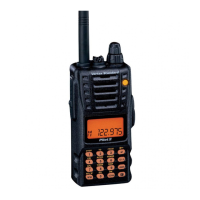

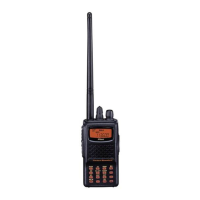
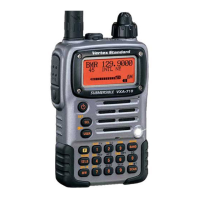


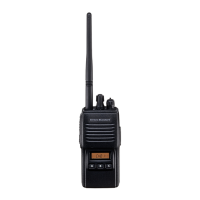

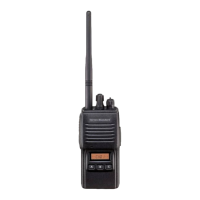
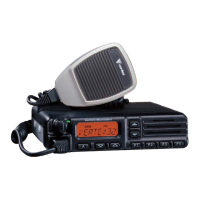
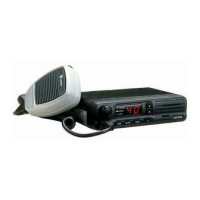

